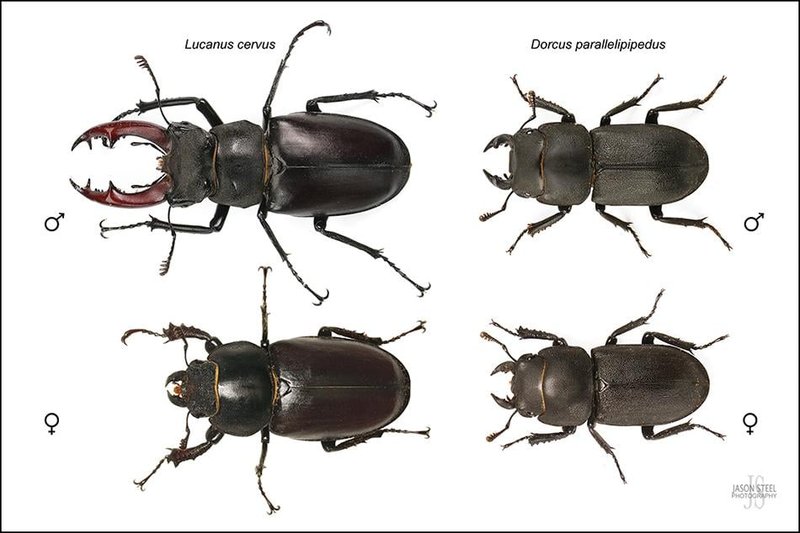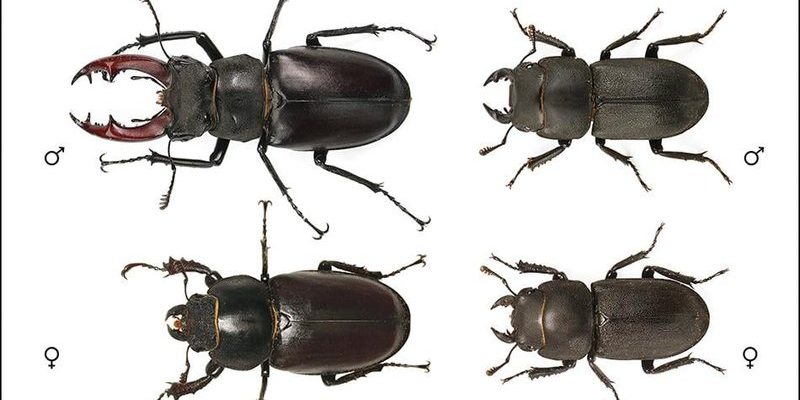
While we’ll focus on the stag beetle, we’ll also take a look at its cousins and other lookalikes. Think of it like comparing your best friend with a friend of a friend—you might notice some familiar traits, but also some notable differences. By the time we’re done, I hope you’ll have a clearer picture of how the stag beetle compares to similar insects.
What is a Stag Beetle?
The stag beetle, belonging to the Lucanidae family, is a striking creature often recognized by its large mandibles, which resemble the antlers of a stag. These pincers are not just for show; they play a crucial role in mating rituals and male-to-male combat. In fact, during the breeding season, male stag beetles will grapple with one another to assert dominance—sounds a bit like the sport of wrestling, doesn’t it?
Stag beetles come in various species, with the most common ones being found in Europe, Asia, and parts of North America. Their size can range quite a bit, from a couple of centimeters to over 15 centimeters long in some species! They often have a dark, shiny exterior, which helps them blend in with their surroundings. Just imagine them crawling around in the leaves, looking for mates or food.
Their life cycle is pretty interesting too. Like many insects, stag beetles undergo complete metamorphosis, which means they begin as eggs, hatch into larvae, pupate, and eventually emerge as adults. Larvae usually develop in decaying wood, munching away until they’re ready to take on the world as full-grown beetles.
Physical Features: What Sets Them Apart?
When you look at a stag beetle, the first thing you might notice is those impressive mandibles. But aside from that, stag beetles have a few other distinct characteristics that set them apart from similar insects. For starters, their bodies tend to be robust and shiny, giving them a glossy appearance as they scuttle around.
You could say their mandibles are like a knight’s sword—impressive and functional. These pincers are specifically designed for fighting, but they also help males attract females. It’s all about showing off! So, in comparison to other insects like the rhinoceros beetle, which has a horn, stag beetles are more about those jaw-like features.
In terms of color, many stag beetles are black or dark brown, although some species can showcase vibrant colors like red or green. This is where things get interesting; many insects use bright colors as a warning signal. But for stag beetles, their darkness usually helps with camouflage, blending them into woodland environments.
Similar Insects: Rhinoceros Beetles and More
Now, let’s bring in some other heavyweights of the insect world for comparison. One of the closest relatives to the stag beetle is the rhinoceros beetle. These guys also have impressive features, like horns on the males—they’re like the bodybuilders of the beetle world!
While stag beetles use their mandibles primarily for combat and mating, rhinoceros beetles use their horns for a similar purpose but also for digging. They’re like a Swiss Army knife, versatile in various situations. Both types of beetles are impressive, but their features serve different functions, depending on their habitat and behavioral needs.
Another similar insect is the Japanese beetle, which is less robust but shares a similar habitat. Unlike the stag beetle, Japanese beetles don’t have those impressive mandibles. Instead, they have a more oval shape and often sport metallic colors. This gives them a slightly different lifestyle, as they feed more on plant matter, while stag beetles are more wood-focused.
Habitat: Where Do These Insects Live?
Stag beetles are like little lumberjacks of the insect world. They prefer habitats that include decayed wood, which serves as both food and shelter. You can often find them in woodlands, parks, and gardens. They thrive in environments rich in organic matter, which makes sense because their larvae feed on rotting wood.
In contrast, rhinoceros beetles tend to prefer more tropical habitats. While both may share a love for trees, rhinoceros beetles thrive in hotter climates, often found in rainforests or warmer, humid locations. This means that while you might spot a stag beetle in a backyard park in Europe, you wouldn’t expect to find a rhinoceros beetle there unless you’re in a warm tropical region.
Japanese beetles, on the other hand, enjoy open fields and gardens. These insects are often seen munching on various plants, making them more of a garden pest compared to the stag beetle. Think of them like the party crashers—while the stag beetles are busy hanging out with trees, the Japanese beetles are having a feast on your prize roses!
Behavior: Mating Rituals and Combat
The behavior of stag beetles is particularly fascinating. Males engage in battles to impress females, using their large mandibles to wrestle opponents. Picture two wrestlers in a ring, trying to show off their skills—only in this case, it’s all about love! These spectacles usually take place near trees, where the females are more likely to be found.
In contrast, the rhinoceros beetle utilizes its horns for a similar purpose, though a lot of their behavior revolves around digging and foraging as well. Unlike stag beetles, they don’t have the same type of elaborate combat but will still engage in some degree of fighting.
When it comes to the Japanese beetle, their behavior is much more focused on feeding and reproduction. They tend to swarm during mating season, creating a frenzied atmosphere in gardens. Think of it like a big party where they just can’t get enough of the plants they adore!
Conservation: Are Stag Beetles in Danger?
Stag beetles, like many other insects, face threats from habitat loss, climate change, and pesticide use. The combination of these factors has led to a decline in their populations across various regions. The loss of old trees and decaying wood—where they lay their larvae—can significantly hinder their ability to thrive.
In many areas, conservation efforts are underway to help protect their habitats. This includes promoting tree planting and reducing pesticide use in gardens. Even simple things, like leaving decaying wood in your backyard, can create a healthier environment for these beetles.
Rhinoceros beetles also face similar challenges, especially in their tropical habitats, where deforestation is a major concern. Meanwhile, Japanese beetles are often viewed as pests, leading to targeted pesticide use that can also harm beneficial insect populations.
Final Thoughts: Understanding Our Insect Friends
In comparing the stag beetle to similar insects, it’s easy to see individuality is key! Each bug has its own unique traits, behaviors, and habitats. Stag beetles charm us with their impressive mandibles, while rhinoceros beetles flex their horns with pride. Understanding these differences helps us appreciate these creatures more.
So, the next time you spot a stag beetle or any of its insect cousins, take a moment to admire their quirks. Nature is full of surprises, and these small beings play vital roles in our ecosystems. Remember, they might be tiny, but their impact is anything but small!

